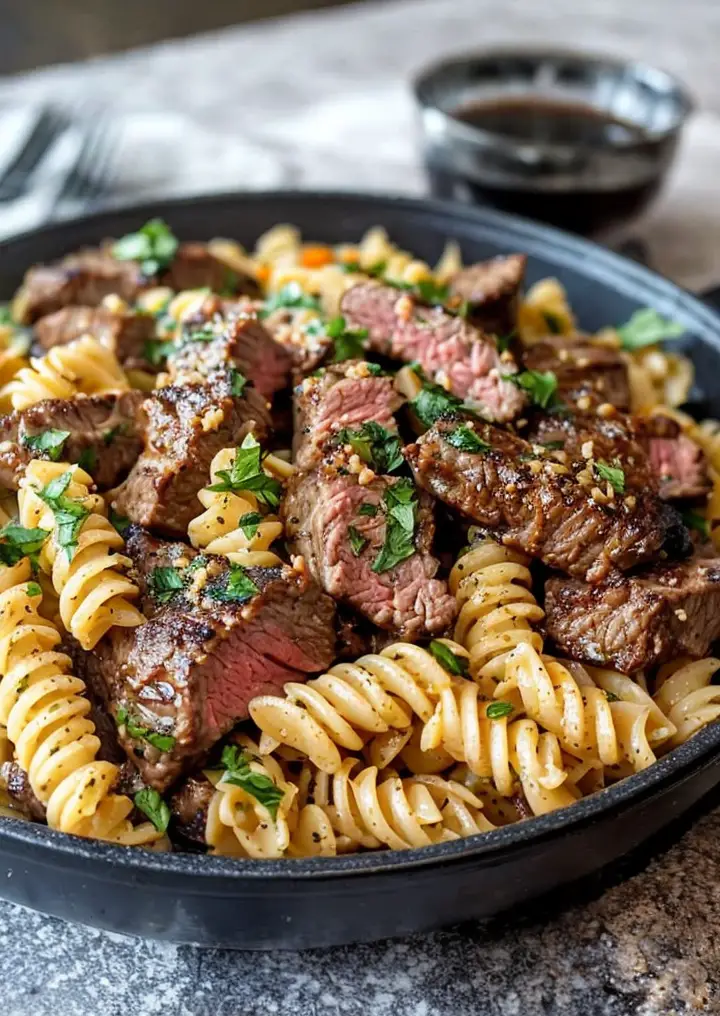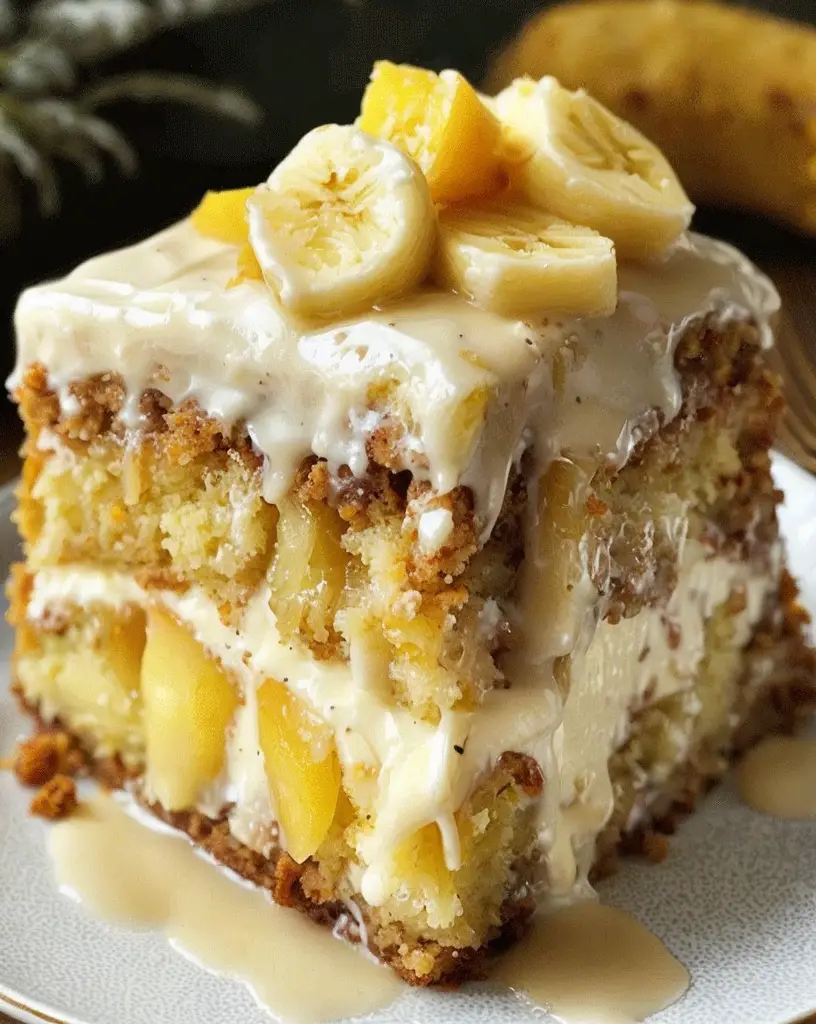Chicken Fried Chicken with Mushroom Cream Sauce: A Comfort Food Classic
Chicken Fried Chicken with Mushroom Cream Sauce is not just a meal; it’s an experience that brings comfort and warmth into any kitchen. This dish features juicy, breaded chicken breasts perfectly fried to a golden crisp, then smothered in a rich, creamy mushroom sauce. The combination of flavors and textures is enough to transport you to a cozy, rustic diner where the smell of fried chicken wafts through the air.
Imagine sitting down to a plate of this inviting dish. As you take your first bite, the crunch of the fried chicken gives way to tender meat, enhanced by the velvety mushroom sauce. The earthy flavor of mushrooms mixed with garlic and freshly cracked pepper creates a symphony of taste that dances on your palate. This is the kind of food that evokes nostalgia, reminding us of family gatherings and shared meals.
Quick Recipe Highlights
- Flavor Profile: A delightful blend of savory, creamy, and buttery notes brought together by seasoned chicken and earthy mushrooms.
- Texture: The dish showcases a satisfying crunch from the fried chicken paired with the smooth, velvety mushroom cream sauce.
- Aroma: A tantalizing blend of frying chicken and the rich fragrance of sautéed garlic and mushrooms fill the kitchen.
- Visual Appeal: The contrasting golden brown chicken and creamy white sauce make for a visually enticing dish that’s perfect for impressing guests.
- Skill Level Needed: While the process requires some attention, anyone with basic frying skills can master this classic recipe.
- Special Equipment: You will need a frying pan, a meat mallet, and a sauce pan for the sauce preparation.
Recipe Overview
- Difficulty Level: This recipe is classified as medium due to the frying technique and sauce preparation at play, both of which require attention to detail but are manageable with practice.
- Category: Ideal for dinner, this dish combines protein and creamy sauce in one hearty entrée, perfect for family meals or date nights.
- Cuisine: With Southern roots, Chicken Fried Chicken is a beloved dish that offers a taste of traditional comfort food, embodying warmth and hospitality.
- Cost: The ingredients are generally affordable, making this recipe not just delicious but also economically viable for families.
- Season: Enjoy this dish year-round, but it pairs exceptionally well with autumn flavors and gatherings during winter festivities.
- Occasion: Perfect for casual family dinners, potluck parties, or cozy celebrations where hearty food is a must.
Why You’ll Love This Recipe
Indulging in Chicken Fried Chicken with Mushroom Cream Sauce is a culinary delight that brings both comfort and satisfaction. The harmonious combination of crispy chicken and luscious sauce creates a flavor profile that captivates any palette. It appeals to the craving for hearty, homestyle cooking, making it a favorite at family gatherings and special occasions.
One of the major benefits of this recipe is its convenience and ease of preparation. While it may seem like a restaurant-level dish, most of the steps are straightforward, allowing you to prepare a feast with minimal fuss. This makes it a fantastic option for weeknight dinners after a long day, ensuring you can serve something delicious without too much hassle.
Nutritionally, this dish offers protein from the chicken, while the mushroom cream sauce adds depth and flavor without excessive complexity. The use of fresh ingredients not only boosts the taste but also provides key vitamins and minerals, creating a well-rounded meal. With thoughtful plating and the right sides, it can cater to various dietary preferences.
Gathering around a family dinner table with someone serving this dish encourages connection and conversation. It’s not just about the food; it’s about the moments and memories created while sharing a heartfelt meal. Guests will rave about this dish, making it a showstopper for dinner parties or celebrations.
Lastly, Chicken Fried Chicken with Mushroom Cream Sauce is cost-effective and accessible. Most ingredients can be found in your pantry or local grocery store, allowing you to easily whip up this comforting favorite without breaking the bank. It’s a practical choice that doesn’t compromise on flavor or presentation.
Historical Background and Cultural Significance
Chicken Fried Chicken has its origins in Southern cuisine, where comfort food runs deep in tradition. This dish likely evolved from traditional fried chicken recipes, with influences from both African American cooking and European immigrant dishes. The method of frying chicken became popular in the South, where buttermilk marinated chicken is a staple.
Culturally, this recipe symbolizes the essence of Southern hospitality, capturing the spirit of community and gatherings. In many households, this dish is a centerpiece for family reunions and celebrations, showcasing the love and care of those who prepare it. It’s a dish that tells stories, preserving a legacy passed down through generations.
Over time, the recipe has evolved, incorporating various cooking styles and flavors. While the classic version features the basic elements of chicken and a simple cream sauce, regional variations often introduce spices, herbs, or even different types of mushrooms, contributing to a diverse culinary landscape.
Today, Chicken Fried Chicken with Mushroom Cream Sauce remains popular across the United States, adapted into various menus from home kitchens to fine dining establishments. Its enduring appeal lies in its comforting nature, reminding us of simpler times and highlighting the transformative power of good food.
Ingredient Deep Dive
Chicken
Chicken is a high-protein, versatile ingredient that forms the backbone of this dish. Historically, it has been a staple in various cuisines globally, celebrated for its ability to absorb flavors and complement a wide range of cooking styles. When selecting chicken for this recipe, choose fresh, organic options whenever possible for the best flavor and nutrition.
Nutritionally, chicken is rich in protein, which is essential for muscle repair and growth. It also contains B vitamins and other important nutrients. For purchase, look for breasts that are plump and have a consistent pink color. When storing, keep it in the coldest part of your refrigerator and use it within a couple of days.
If fresh chicken is not available, frozen chicken can be a great substitute, although it’s essential to thaw it properly before cooking. Other poultry such as turkey could also work as a protein alternative, although it will offer a difference in taste and texture.
Mushrooms
Mushrooms are the star of the creamy sauce that accompanies this dish. With a rich history in various cuisines, mushrooms have long been revered not only for their earthy flavor but also for their health benefits. When incorporating mushrooms into your dishes, it’s best to select varieties like cremini or button mushrooms, both of which hold up well in cooking.
These fungi are remarkably low in calories but packed with essential nutrients such as selenium, potassium, and vitamins B and D. When selecting mushrooms, choose ones that are firm and free from dark spots. Store them in a paper bag in the fridge to extend their shelf life and avoid using plastic, which can cause them to spoil faster.
If fresh mushrooms aren’t available, dried mushrooms can be rehydrated and used as a flavorful substitute. Alternatively, if you want to introduce different flavors, consider experimenting with varieties like shiitake or portobello, which provide unique tastes and textures in the sauce.
Common Mistakes to Avoid
- Overcooking the chicken, which can lead to dryness; be sure to monitor the temperature.
- Not using enough oil for frying, which can result in uneven cooking and soggy chicken.
- Skipping the resting time after frying, which allows the juices to redistribute within the chicken.
- Using cold chicken straight from the fridge; letting it sit at room temperature for about 15 minutes prior to cooking helps achieve even cooking.
- Neglecting the seasoning; adding salt and pepper to both the chicken and the sauce enhances flavor dramatically.
- Rushing the mushroom sauce preparation; let the mushrooms cook thoroughly to develop their flavor.
- Not draining excess oil after frying, leading to greasy chicken; use paper towels to absorb any extra fat.
- Overcrowding the frying pan, which causes temperature drops and uneven cooking.
- Using old spices in the sauce; fresh spices lend much more flavor.
- Forgetting to taste as you go; adjust the seasoning to your liking for the best results.
Essential Techniques
Frying Chicken
Frying chicken is an essential technique for achieving that golden, crispy exterior while keeping the meat tender. Start by properly heating the oil to the right temperature, as this is critical for ensuring the chicken crisps up beautifully without absorbing too much oil. To master this technique, it’s important to use a deep frying thermometer to monitor the oil temperature consistently.
Be aware of common pitfalls like overcrowding the pan, which can cause the oil temperature to drop, leading to soggy chicken. Visual cues for success include a consistent bubble action in the oil when chicken is added, as well as a golden brown crust indicating doneness.
Preparing a Cream Sauce
Creating a creamy mushroom sauce involves the culinary technique of creating a roux, which thickens the sauce. Start by sautéing the mushrooms in butter until they release their moisture and become tender, then add flour to create the roux. The key is to continuously whisk while adding liquid (such as chicken broth or cream) to ensure a smooth texture.
To master this technique, pay attention to the consistency of the sauce as you mix; it should be creamy without lumps. A common pitfall is allowing the sauce to boil too long, which can curdle the cream. Watch closely for achieving that perfect silky finish.
Pro Tips for Perfect Chicken Fried Chicken with Mushroom Cream Sauce
1. Marinate the chicken in buttermilk overnight for enhanced flavor and tenderness. This acid helps break down meat fibers, resulting in juicier chicken.
2. Always pat the chicken dry before breading to ensure the coating adheres properly.
3. For extra crunch, double-dip the chicken in egg wash and breadcrumbs or flour before frying.
4. Maintain a stable oil temperature during frying by adjusting the heat as required; this allows for even cooking and prevents sogginess.
5. Infuse your mushroom sauce with herbs like thyme or parsley for an elevated flavor profile.
6. Always taste and adjust seasonings in each component of the dish; flavor building is essential for a balanced final result.
7. Let the finished chicken rest on a wire rack to keep it crispy while you prepare the rest of your meal.
8. Consider garnishing with fresh herbs for a pop of color and freshness in presentation.
Variations and Adaptations
For a regional twist, consider using local mushrooms or adding Southern spices like Cajun seasoning to the flour mix for frying. During autumn, incorporating seasonal ingredients like pumpkin or sage can elevate the dish to reflect seasonal flavors.
If dietary modifications are needed, you can use gluten-free breadcrumbs or almond flour for those avoiding gluten. Additionally, for a lighter version, consider baking the chicken instead of frying, resulting in a healthier option without compromising too much on flavor.
Flavor variations can also be achieved by adding cheeses like parmesan to the mushroom sauce for richness. For an interesting twist, experiment with adding balsamic vinegar or white wine to the sauce to enhance its depth and flavor complexity.
Presentation can also be adapted to include unconventional sides, such as cauliflower puree or roasted seasonal vegetables, which lend a fresh contrast to the hearty chicken and sauce.
Serving and Presentation Guide
Plating is key to making any dish appealing. Serve Chicken Fried Chicken on a rustic wooden board or a simple white plate to highlight the vibrant colors. Drizzling the mushroom cream sauce over the chicken creates an inviting look, and a sprinkle of fresh chopped parsley adds a touch of color and freshness.
Garnishing with lemon wedges can provide a refreshing contrast and elevate the dish. Serve along traditional sides like mashed potatoes or collard greens to create a fully immersive Southern dining experience. For modern flair, consider placing the chicken atop a bed of creamy polenta or risotto, incorporating different textures while serving.
Temperature considerations are crucial; serve the dish hot for the best flavor and experience. Remember to control portions by cutting the chicken into manageable portions or offering a family-style serving that encourages sharing.
Wine and Beverage Pairing
Pair your Chicken Fried Chicken with a light-bodied red wine like Pinot Noir, which complements the savory flavors without overpowering them. Alternatively, a crisp white wine such as Chardonnay can enhance the buttery notes of the mushroom cream sauce beautifully.
For non-alcoholic options, consider serving iced tea or a citrus-infused sparkling water to cleanse the palate and add brightness. If coffee is more your style, a robust dark roast pairs seamlessly, enhancing the earthy elements of the dish.
Temperature plays an essential role; serve whites chilled and reds slightly below room temperature to enhance their character. Offer drinks in versatile glassware to maintain a relaxed yet refined atmosphere during dining.
Storage and Shelf Life
When storing leftovers of Chicken Fried Chicken with Mushroom Cream Sauce, allow it to cool down completely before placing it in airtight containers. Ideally, consume the dish within three to four days to ensure quality and safety.
Refrigerate the chicken and sauce separately if possible, as this helps maintain the crispy texture of the chicken. Signs of spoilage include off-odors, changes in texture, or an unusual film on the sauce.
For reheating, place chicken back in the oven at a low temperature to restore its crispness. Alternatively, the microwave can be used but may result in sogginess. Freezing the dish is possible but may alter the texture of the cream sauce; when thawing, ensure that it is thoroughly heated again before serving.
Make Ahead Strategies
To streamline your cooking process, consider preparing the mushroom cream sauce a day in advance. This strategy allows the flavors to meld beautifully, creating a more robust taste when served. Store the sauce separately and reheat it just before serving.
For the chicken, you can bread the pieces ahead of time and keep them in the refrigerator, ready for frying. This minimizes active cooking time and allows you to focus on bringing everything together smoothly.
For optimal quality, consider assembling a timeline for preparation. One effective strategy is to cook and slice the chicken ahead of time, then quickly re-warm the pieces and drizzle them with sauce right before serving. This approach results in fresher flavors and a delightful presentation.
Include fresh herbs or garnishes just prior to serving to maintain their vibrancy. This adds a bright pop of color and elevates the overall aesthetic of the dish.
Scaling Instructions
Scaling this Chicken Fried Chicken recipe is straightforward. For smaller portions, halve the ingredient quantities while ensuring the cooking times remain the same; just be cautious with the oil quantity.
If you’re looking to double or triple the recipe for a larger gathering, ensure you’re using adequately sized cookware. Fry in batches to keep oil temperatures consistent, thus maintaining the quality and texture of the chicken.
Adjusting cooking times may be necessary when scaling, especially with larger quantities of chicken, to ensure thorough cooking and food safety. Use a meat thermometer to confirm doneness while cooking larger batches.
For storage, plan for larger containers to accommodate the increased volume, ensuring the same method is used for refrigerating and freezing leftover portions.
Nutritional Deep Dive
When analyzing the nutritional content of Chicken Fried Chicken with Mushroom Cream Sauce, it’s beneficial to break it down into macronutrients. A single serving generally contains protein from the chicken, carbohydrates from any accompanying side dishes or breading, and fats mainly from frying oils and cream.
Micronutritionally, this dish includes valuable vitamins and minerals, particularly when incorporating mushrooms known for their vitamin D and B content. The addition of herbs not only enhances flavor but also provides added nutrients.
For health-conscious individuals, balancing portions of protein and carbohydrates can be essential. Moreover, intentional preparation methods like baking the chicken instead of frying can drastically reduce calorie counts while maintaining flavor.
When considering weight management tips, focus on controlling portion sizes and complementing the dish with an array of vegetables, which can provide volume and fiber without excessive calories.
Dietary Adaptations
For gluten-free versions of Chicken Fried Chicken, substitute traditional flour with gluten-free alternatives like almond flour or gluten-free breadcrumbs. This allows those following a gluten-free diet to enjoy the dish without sacrificing taste.
If you require a dairy-free version, consider using coconut cream instead of heavy cream in the sauce. Nutritional yeast can also be added for a cheesy flavor without dairy.
For a low-carb option, you can forego breading the chicken entirely and simply grill or bake it, pairing it with a homemade mushroom sauce made with low-carb thickeners, such as xanthan gum.
Vegan adaptations can replace chicken with firm tofu, preparing it in a similar breading style, and using cashew cream mixed with sautéed mushrooms for the sauce. This ensures a creamy, rich flavor that’s entirely plant-based.
Troubleshooting Guide
If the chicken texture isn’t crispy, ensure that the oil is hot enough before adding the chicken. A thermometer can help maintain the right cooking temperature, assisting in achieving that perfect crunch.
For flavor balance, always taste throughout the cooking process to adjust seasonings. If the sauce turns out too thick, slowly whisk in broth or cream until reaching the desired consistency.
If your ingredients are not cooperating or frying satisfactorily, introducing fresh oil or adjusting cooking batches can dramatically improve results. Always look out for over frying, which can burn breading without cooking the meat through.
Timing is crucial; ensure to follow suggested times closely and remember that chicken pieces vary in size; using a meat thermometer will guarantee proper cooking.
Recipe Success Stories
This Chicken Fried Chicken recipe has been popular among families and friends for years, with many sharing their own variations. Community feedback often highlights how the dish serves as a comforting reminder of family gatherings and celebrations.
Readers have shared adaptation success stories like using different spices or incorporating regional flavors that showcase their local culinary culture. These unique adjustments demonstrate how versatile the dish can be while still maintaining its classic essence.
Photographs shared by home cooks show the beautiful plating of the dish, illustrating the vibrant and inviting presentation that makes this dish a staple at dinner tables. Suggestions from readers continue to inspire improvements that keep the recipe fresh and engaging.
Frequently Asked Questions
How can I make the chicken less greasy?
To reduce greasiness, ensure you’re using enough oil at the right temperature during frying. Additionally, allow the fried chicken to drain on paper towels to absorb excess oil before serving.
Can I prepare the mushroom cream sauce in advance?
Yes! The mushroom cream sauce can be prepared a day ahead and stored in the refrigerator. Just reheat it gently on the stovetop while stirring to maintain creaminess before serving.
What sides pair well with Chicken Fried Chicken?
Classic sides include mashed potatoes, coleslaw, or green beans. You can also try serving it with a fresh garden salad for a balanced meal.
Can I freeze leftover Chicken Fried Chicken?
Yes, you can freeze leftover chicken, but the creamy sauce may not maintain its texture. It’s best to freeze chicken and sauce separately for optimal quality.
What type of oil is best for frying?
Choosing oils with high smoke points works best for frying. Vegetable oil, canola oil, or peanut oil are excellent options for achieving that golden-brown crust.
Is there a way to make it healthier?
For a healthier version, consider baking the chicken instead of frying or use whole grain breadcrumbs. You could also use low-fat dairy alternatives in the sauce.
Can I adapt this recipe for dietary restrictions?
Absolutely! Substitutions for gluten-free, dairy-free, vegan, and low-carb diets are all possible. Explore specific ingredient sways that cater to your unique dietary needs.
What kind of chicken works best?
Boneless, skinless chicken breasts are ideal for this recipe as they remain tender during frying. You can also use thighs for extra flavor if preferred.
How do I prevent the chicken from drying out?
Marinating chicken in buttermilk before cooking can help lock in moisture. It’s also essential not to overcook your chicken while frying.
What type of mushrooms should I use?
Creamy button or cremini mushrooms are preferred for this sauce as they provide a good flavor and texture. Feel free to experiment with other varieties to suit your taste.
What’s the best way to reheat leftovers?
The best way to reheat leftovers is to use the oven at a low temperature to maintain crispiness. Microwaving can cause the chicken to become soggy.
Additional Resources
If you enjoyed this Chicken Fried Chicken with Mushroom Cream Sauce recipe, explore similar dishes like creamy chicken casseroles and classic fried chicken recipes.
Check out technique guides for mastering frying at home, essential cooking tips for perfecting sauces, as well as ingredient information on selecting quality mushrooms and herbs to enhance other meals.
Also, consider kitchen equipment recommendations for frying and sautéing, ensuring you have everything you need for perfect preparation. Adapt your meals to seasonal variations by including fresh produce and herbs that complement the flavors of this delicious dish.
Join the Conversation
We want to hear from you! Share your own experiences making Chicken Fried Chicken with Mushroom Cream Sauce or any variations you’ve tried.
Don’t forget to share your cooking photos on social media and engage with our community to inspire others with your creativity in the kitchen.
Leave recipes reviews, provide suggestions, or ask questions to foster a vibrant community around this beloved comfort food. Your input helps everyone become better cooks and enhances the joy of sharing great meals!
The Recipe
Chicken Fried Chicken with Mushroom Cream Sauce
Serves: 4 servings
Prep Time: 20 mins
Cook Time: 30 mins
Total Time: 50 mins
Kitchen Equipment Needed
- Frying pan
- Meat mallet
- Large mixing bowl
- Measuring cups and spoons
- Whisk
- Spatula
Ingredients
- 4 boneless, skinless chicken breasts
- 1 cup buttermilk
- 1 cup all-purpose flour
- ½ teaspoon paprika
- Salt and black pepper to taste
- Vegetable oil, for frying
- 8 ounces mushrooms, sliced
- 2 tablespoons butter
- 2 tablespoons all-purpose flour (for the sauce)
- 1 cup chicken broth
- ½ cup heavy cream
Directions
- In a large bowl, combine the chicken breasts with buttermilk, salt, and pepper. Let it marinate for at least 30 minutes.
- In another bowl, mix flour, paprika, salt, and pepper. Take the chicken out from the marinade and coat each piece with the flour mixture.
- Heat oil in a frying pan over medium heat. Once hot, fry the chicken pieces until golden brown on each side, about 5-7 minutes per side. Drain on paper towels.
- For the sauce, melt butter in another pan over medium heat. Add sliced mushrooms and sauté until tender.
- Sprinkle flour over the mushrooms and stir for a minute, then gradually add chicken broth while whisking to avoid lumps.
- Stir in heavy cream and simmer until thickened, seasoning with salt and pepper to taste.
- Serve the fried chicken hot, topped with mushroom cream sauce.
Recipe Notes
- For added flavor, consider marinating the chicken overnight.
- Leftover chicken can be stored in the refrigerator for up to 4 days.
- Try adding fresh herbs to the sauce for different flavor notes.




